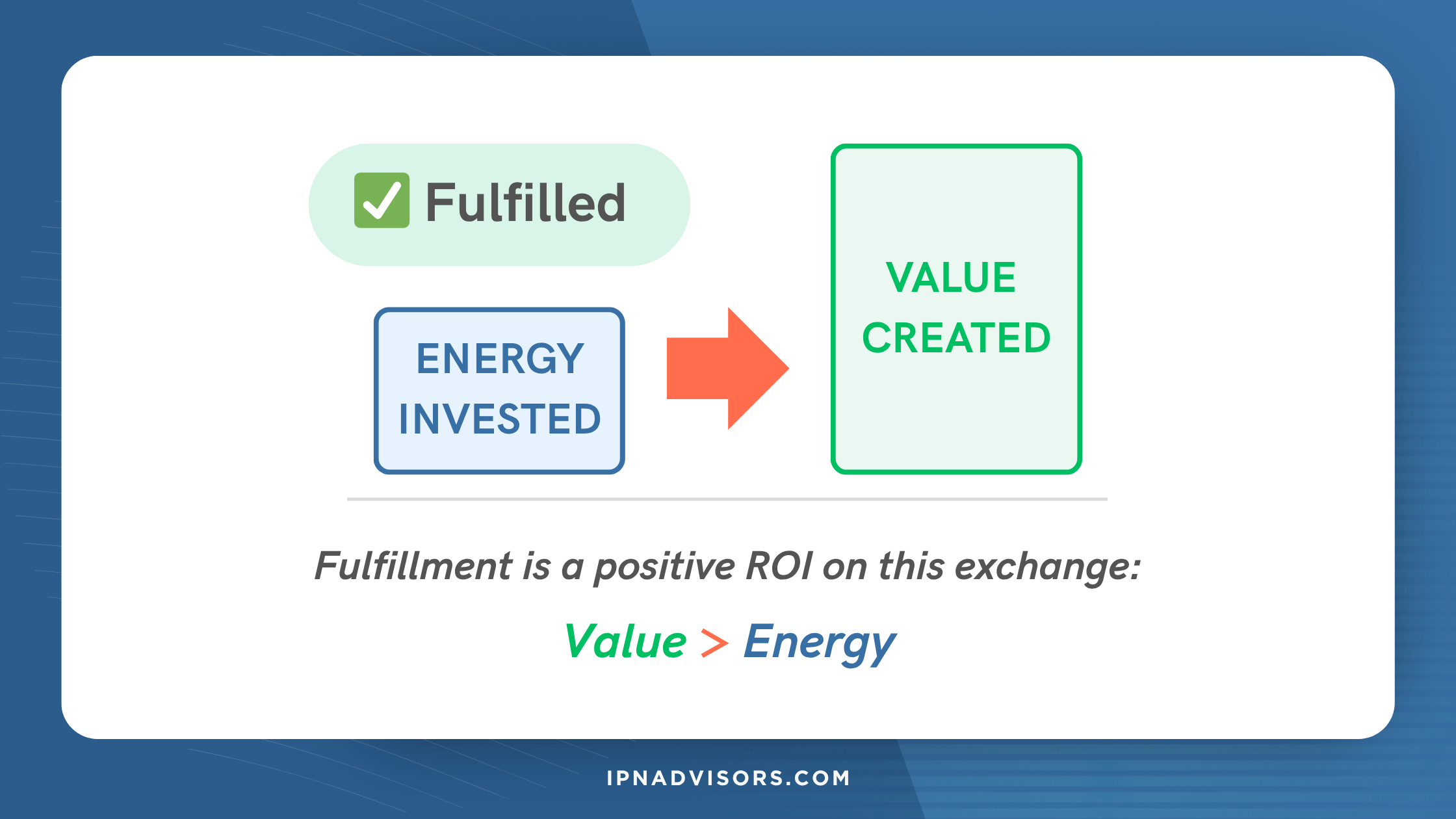Fulfillment ROI: The Missing Metric Every Leader Should Track
What if we told you there's a simple formula that could revolutionize how you think about work, leadership, and organizational success?
It's not another complex framework or lengthy assessment. It's something we call Fulfillment ROI, and it might be the most important metric you're not tracking.
The Formula That Changes Everything
Fulfillment ROI is elegantly simple:
Value Created > Energy Invested
When the value you create exceeds the energy you put in, you experience fulfillment. When energy consistently outweighs value, you're on a direct path to burnout, disengagement, and organizational dysfunction.
But here's what makes this profound: fulfillment isn't just a nice-to-have feeling—it's the only true basis for sustainability.
Our Journey to This Discovery
This concept comes from our co-founder, Matt. Here's what he's shared with the team about the concepts origins.
"For years, I chased fulfillment like a moth at a lantern convention. Tech startups, social justice work, ministry, corporate America, consulting—I was SUPER excited each time, convinced I'd found "it." But fulfillment remained elusive, just fleeting moments rather than a sustainable state of being.
"Then came March 2020. Like everyone else, I was forced to slow down and go deep. What I realized was that each time I started to lose my sense of fulfillment it was because things became "too hard" or "too fuzzy". In other words they were taking too much energy or were not producing enough clear value.
"That's when the Fulfillment ROI concept crystallized."
Why This Formula Matters
Value Created > Energy Invested isn't just about personal satisfaction—it has profound implications for how we work and lead.
The Sustainability Connection
When your Fulfillment ROI is positive, it creates a buffer against inevitable bumps in the road. Those bumps always manifest as either increased energy investment or reduced value creation.
But if you're starting from a positive ROI position, you can weather these storms and stay on a sustainable path.
The Great Resignation Through This Lens
The "Great Resignation" makes perfect sense when viewed through Fulfillment ROI. The pandemic forced people to reassess the value they were creating while stripping many roles down to bare essentials.
People suddenly saw the Matrix—how their energy inputs were (or weren't) creating proportional value. Many realized their work simply wasn't "worth it."
Now we're in a period where people are consciously questioning what provides a positive ROI. They're optimizing for fulfillment, not just paychecks.
The Two Levers: Catalyzing and Vectoring
To improve your Fulfillment ROI, you have two strategic approaches:
Catalyzing (Reducing Energy Investment)
Improve consistency through better processes
Get clarity on scope, roles, and accountabilities
Increase psychological safety
Focus on mastery, not just performance
Know your natural drivers and reduce energy "stretch"
Vectoring (Increasing Value Creation)
Articulate and share purpose and "why"
Get and respond to stakeholder feedback
Build emotional and relational trust
Stay curious and innovative
Define and share metrics of success
Practical Application for Leaders
Individual Assessment
Ask yourself honestly:
Are you generally energized or drained by your daily work?
Is the value you're creating proportional to the effort you're investing?
What would change if you optimized every decision for Fulfillment ROI?
Team Assessment
Look for these signs:
High Fulfillment ROI: Teams feel challenged but not overwhelmed, processes feel smooth but not stagnant, growth feels exciting rather than chaotic
Low Fulfillment ROI: Working harder with diminishing returns, talented people leaving due to exhaustion, processes that drain energy without creating value
Organizational Strategy
Audit your energy drains: What consistently frustrates your team without adding value?
Clarify value creation: How does each role contribute to meaningful outcomes?
Design for both: Build systems that reduce friction while increasing engagement
The Leadership Imperative
At IPN Advisors, we don't use the term "work" to describe what we do. Instead, we talk about "catalyzing" and "vectoring." This isn't just semantic—it shifts how we approach every project, every client relationship, every internal process.
When you optimize for Fulfillment ROI, everything else gets easier:
Retention improves because people feel energized by their contributions
Innovation increases because energy isn't drained by friction
Customer satisfaction rises because fulfilled teams create better outcomes
Growth becomes sustainable because it's built on a foundation of positive energy exchange
Your Next Steps
Calculate Your Current ROI: Honestly assess whether your energy investment is creating proportional value
Identify Quick Catalyzing Wins: What processes or policies could immediately reduce energy drain?
Clarify Your Vectoring Opportunities: Where could you increase the impact and meaning of current efforts?
Design for Sustainability: Build Fulfillment ROI thinking into your decision-making frameworks
The Bottom Line
Fulfillment ROI isn't just a personal development concept. It's a competitive advantage.
We're living in a moment where talent has choices and burnout is epidemic. Organizations that master the art of creating high-value, energizing work experiences will win.
The question isn't whether you can afford to focus on Fulfillment ROI. The question is whether you can afford not to.
Because when people are fulfilled—when their value creation exceeds their energy investment—magic happens. They bring their best selves to work. They innovate. They stay. They thrive.
And ultimately, they help your organization do the same.
Ready to optimize your Fulfillment ROI? At IPN Advisors, we specialize in helping leaders and organizations find that sweet spot where operational excellence meets organizational health. Let's start the conversation →



